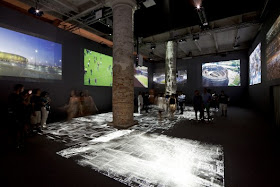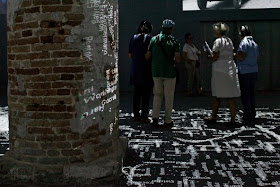A
GATEWAY DESIGN BY NORMAN FOSTER
VENICE ARCHITECTURE BIENNALE 2012
GATEWAY DESIGN BY
NORMAN FOSTER
VENICE ARCHITECTURE BIENNALE 2012
For the 13th Venice
Biennale, Norman Foster was
invited to create two exhibitions. On the one hand, there’s Central
Pavilion, “Hong Kong and
Shanghai Bank HQ”, specifically commissioned by David
Chipperfield, which presents how a public space, created by physically lifting
a tower to make a space at its base, has been used by people over time.
On the other hand,
we find “Gateway.” Located
at the beginning of the Arsenale, it is one of the first spaces the public
encounters at the Biennale. In this installation, viewers are presented with an
intense dose of images and words, representing different types of buildings and
spaces, criss-crossed with the names of the architects, designers and planners
that have influenced our built environment over the years.
Situated
at the head of the Arsenale, Gateway is one of the first spaces encountered by
visitors, who pass from the light-filled entrance into the black box of the
main space. The floor, and the crowd that gathers and passes across it, are
washed by hundreds of words, glowing white in the dark and constantly in
motion. The words are the names of individuals who, from antiquity to the
present, have influenced the design of our cities and buildings. Finnish-based
artist Charles Sandison has created a site-specific work for this event.
Enormous, constantly
changing images, ranging from the historical spaces of the Western world to the
new cities and favelas of Asia and South America, are projected onto the high
wall above the heads of the visitors.
The pictures also
show spaces that resonate with social change -order and disorder- from the Arab
Spring to the London riots. Woven into these sequences are interior spaces of
museums, stadia, termini, and other public buildings.
In the spirit of
common ground, the images have been solicited from a global network of
architects, planners, photographers, critics, writers, and artists. These
stills have been combined to make film sequences by the Ivorypress Team lead by
Elena Ochoa Foster, with Antonio Sanz as production designer and in
collaboration with Carlos Carcas as photomontage editor.
VENICE ARCHITECTURE BIENNALE 2012
NORMAN FOSTER
CHAIRMAN + FOUNDER
Norman Foster was born in Manchester. After graduating from
Manchester University School of Architecture and City Planning in 1961 he won a
Henry Fellowship to Yale University, where he was a fellow of Jonathan Edwards
College and gained a Master’s Degree in Architecture.
In 1963 he co-founded Team 4 and in 1967 he established Foster
Associates, now known as Foster + Partners. Founded in London, it is now a
worldwide practice, with project offices in more than twenty countries. Over
the past four decades the company has been responsible for a strikingly wide range
of work, from urban masterplans, public infrastructure, airports, civic and
cultural buildings, offices and workplaces to private houses and product
design. Since its inception, the practice has received 470 awards and citations
for excellence and has won more than 86 international and national competitions.
Norman Foster was awarded the Royal Gold Medal for Architecture in
1983, the Gold Medal for the French Academy of Architecture in 1991 and the
American Institute of Architects Gold Medal in 1994. Also in 1994, he was
appointed Officer of the Order of Arts and Letters by the Ministry of Culture
inFrance. In 1999 he became the twenty-first Pritzker Architecture Prize
Laureate; and in 2002 he was elected to the German Orden Pour le Mérite für
Wissenschaften und Künste and awarded the Praemium Imperiale. He was granted a
Knighthood in the Queen’s Birthday Honours List, 1990, and appointed by the
Queen to the Order of Merit in 1997. In 1999 he was honoured with a life
peerage in the Queen’s Birthday Honours List, taking the title Lord Foster of
Thames Bank.
NORMAN FOSTER PARTNER
THE WAY WE WORK
From the beginning, we have pioneered a sustainable approach to
design, through work that spans the spectrum from masterplans to furniture. Our
approach is sensitive to location and culture, often combining the latest advances
in building technology with techniques drawn from vernacular tradition; and we
harness the skills, enthusiasm and knowledge of integrated design teams,
clients and communities to create inspirational environments.
By working together creatively from the start of a project,
architects and engineers combine their knowledge to devise integrated,
sustainable design solutions. From appointment to completion, the design teams
are supported by numerous in-house disciplines, including project management and
a construction review panel. And to ensure consistency and personal service,
the same core team sees a project through from beginning to end. The design
process is reviewed regularly by the Design Board, and the practice is led by the
Partnership Board.
DESIGN BOARD
The design of each project is reviewed regularly, both formally and
informally, under the direction of the Design Board, which is led by founder
and Chairman Norman Foster, Stefan Behling, Grant Brooker, Nigel Dancey,Spencer de Grey, Gerard Evenden, Luke Fox, Paul Kalkhoven,David Nelson and David Summerfield.
The Design Board has full responsibility for design within the office.
While its involvement is important in the early, conceptual design
phases, it ensures continuity and quality at every stage of a project, as well
as encouraging the sharing of expertise across the project teams. The Design
Board was created in the spirit of challenging and being challenged. It also
plays an important role in stimulating research, as well as in arranging cross-disciplinary
design workshops on various issues, such as urban design and sustainability.
http://www.fosterandpartners.com/about-us/design-board/




















